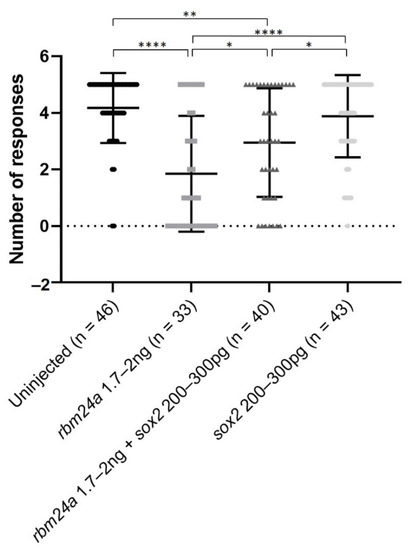- Title
-
Functional Role of the RNA-Binding Protein Rbm24a and Its Target sox2 in Microphthalmia
- Authors
- Brastrom, L.K., Scott, C.A., Wang, K., Slusarski, D.C.
- Source
- Full text @ Biomedicines
|
Mutation of rbm24a phenocopies morpholino knockdown. (A) Schematic for genetic structure of Rbm24a, with the RNA recognition motif (RRM) in blue and the Ala-rich region in green. The red line indicates the site of the Alt-R CRISPR/Cas0 mutation. (B) Uninjected control 4 dpf embryo with wild type morphology. (B’) Detail of eye shown in B. (C) and (D) are Alt-R CRISPR/Cas9-injected embryos showing the variation of the phenotypes. (C’) and (D’) are detail of eyes found in C and D, respectively. (E) Graph of uninjected and CRISPR-injected F0 embryos. (F) Synthego ICE analysis of mutations found in F0 mutants. Indels are listed. Images taken at 33×. PHENOTYPE:
|
|
Suppression of rbm24a morpholino knockdown with rbm24a RNA. (A) Uninjected 4 dpf embryo with wild type morphology, (A’) detail of eye in A. (B) Knockdown of rbm24a at low doses leads to microphthalmia, (B’) detail of eye in B, while (C) is a higher dose showing microphthalmia with cardiac edema, (C’) detail of eye in C. (D) Injection of rbm24a RNA yields phenotypes similar to higher dose knockdown, (D’) detail of eye in D. (E) Sequential injection of rbm24a morpholino and rbm24a RNA suppresses the phenotypes, (E’) detail of eye in E. (F) Graph of phenotypes. Images taken at 33×. PHENOTYPE:
|
|
EGFP RNA does not suppress rbm24a knockdown. (A) Uninjected and EGFP RNA-injected 1 dpf embryos are shown in both brightfield (top) and with a GFP filter (bottom). (B) Uninjected 4 dpf embryo with wild type morphology, (B’) detail of eye in B. (C) rbm24a knockdown embryos display microphthalmia with cardiac edema, (C’) detail of eye in C. (D) Sequential injection of rbm24a morpholino and EGFP RNA yields phenotypes similar to knockdown alone, (D’) detail of eye in D. (E) EGFP RNA-injected embryos are morphologically wild type, (E’) detail of eye in E. (F) Graph of phenotypes. Image A taken at 62×. Images B-E’ taken at 33×. |
|
Exogenous sox2 can suppress rbm24a-associated microphthalmia. (A) Uninjected 4 dpf embryo with wild type morphology, (A’) detail of eye in A. (B) Knockdown of rbm24a at low doses leads to microphthalmia, (B’) detail of eye in B. (C) Sequential injection of rbm24a morpholino and sox2 RNA results in a phenotype more similar to wild type than rbm24a morphant, (C’) detail of eye in C. (D) Injection of sox2 RNA alone results in wild type morphology, (D’) detail of eye in D. (E) Graph of phenotypes. Images taken at 33×. |
|
EGFP RNA does not improve visual function of rbm24a knockdown embryos. Automated startle response assay (VIZN) was performed on uninjected, rbm24a knockdown, rbm24a knockdown with EGFP RNA, and EGFP RNA larvae. Knockdown of rbm24a inhibits visual function, which was statistically significant compared to uninjected. Addition of EGFP RNA to rbm24a knockdown does not statistically significantly increase visual function when compared to rbm24a knockdown alone. Injection of EGFP RNA alone does not statistically significantly alter visual function from uninjected. Mann–Whitney *** p < 0.001, **** p < 0.0001. Nonsignificant interactions not shown. PHENOTYPE:
|
|
Injection of sox2 RNA can partially restore visual function by VIZN to rbm24a knockdown embryos. VIZN was performed on uninjected, rbm24a knockdown, rbm24a knockdown with sox2 RNA, and sox2 RNA larvae. Knockdown of rbm24a statistically significantly inhibits visual function when compared to uninjected. Addition of sox2 RNA to rbm24a knockdown statistically significantly improves visual function when compared to rbm24a knockdown, but not to the same level as uninjected. Injection of sox2 RNA alone does not statistically significantly alter visual function from uninjected. Mann–Whitney * p < 0.05, ** p < 0.01, **** p < 0.0001. Nonsignificant interactions not shown. PHENOTYPE:
|
|
Model for Rbm24a in zebrafish eye development. (A) Functional Rbm24a is found in the developing lens of zebrafish. There, the protein acts to bind to and stabilize sox2 mRNA. This interaction leads to the development of a normal sized lens and, with reciprocal induction signaling between the lens and retina, the retina also develops normally to size-match the lens. (B) With either knockdown or mutation of rbm24a, there is lessened Rbm24a protein in the lens which in turn cannot stabilize as many sox2 mRNA molecules (represented as transparent shapes). The lack of the correct amount of sox2, a proliferative factor, causes the lens to develop smaller than normal. However, reciprocal induction has not been affected, which leads to the lens and retina developing small in tandem. |







